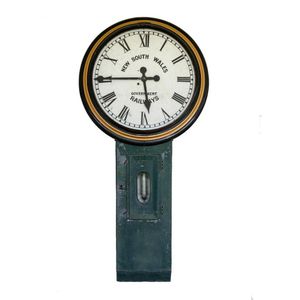Large NSWGR platform clock with visible pendulum
N.S.W. Government Railways platform clock. This imposing clock, the largest size issued, originally came from Blacktown station and for the past 35 years has graced the southern portico of Leuralla. The English weight driven clock tower movement was cased at Eveleigh Workshops to a NSWGR design. The large dial is fitted to a cast iron frame, the glazed door hinged at the top above a 2.3 metre long galvanised tin case which allows for 1 weeks travel of the weight. Unlike the example at central station this has the feature of a visible pendulum (one second oscillation). Also visible is the brass plaque inventory number, 286. This clock is fully functional, the face has areas of paint loss and lifting, losses and ageing of case paint. Later addition of a padlock to glazed pendulum door. Removal will be the responsibility of the purchaser. Height 231 cm, diameter 90 cm (face), width 50 cm (case), depth 31 cm.
You must be a subscriber, and be logged in to view price and dealer details.
Subscribe Now to view actual auction price for this item
When you subscribe, you have the option of setting the currency in which to display prices to $Au, $US, $NZ or Stg.
This item has been sold, and the description, image and price are for reference purposes only.
- Movement - The technical name for the workings of a clock or watch, and does not include the dial or case.
- Pendulum - The pendulum was discovered around 1602 by Galileo Galilei, and was adopted for time keeping by the Dutch mathematician and natural philosopher, Christiaan Huygens, who excelled in astronomy, physics, and horology.
The pendulum comprises a metal rod usually of brass or steel with a metal disk, known as a bob, at the end. The movement of the pendulum is driven by weights or a spring, and as a pendulum swings in a regular arc, it was found accuracy could be controlled to within a few seconds a week.
Timekeeping can be adjusted by changing the height of the bob on the rod, making the pendulum either swing slower or faster.
The disadvantage of the pendulum was that changes in temperature also changed the length of the pendulum, interfering with the accuracy of the clock, and so in the 18th century two types of mercurial pendulums were invented which countered the movement in the steel rod.
The pendulum was the world's most accurate timekeeping technology until the invention of the quartz clock, regulated by a quartz crystal, in 1927.
This item has been included into following indexes:
